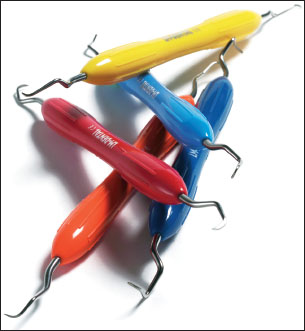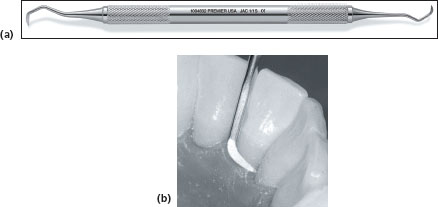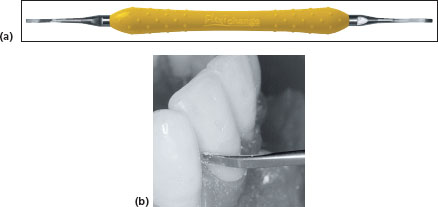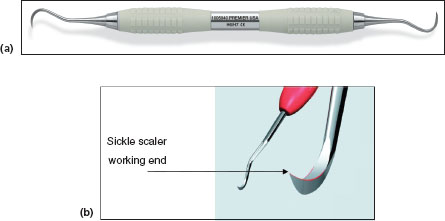SECTION 17
INSTRUMENTS USED IN PERIODONTAL PROCEDURES
Maintenance of the health of the periodontium (gingiva, periodontal ligament and alveolar bone) is vital for an individual’s overall dental health. Disease of the periodontium is referred to as periodontal disease and is a common dental problem. The dental team uses specialised instruments to maintain good periodontal health or to reverse the effects of periodontal disease.



VARIOUS PERIODONTAL PROBES
FIGURE 17.1
Name
Williams periodontal probe
Function and feature
- Used to probe the depth of a periodontal pocket, allowing the operator to measure the pocket depth by reading the markings
- Working end is marked in millimetres to measure periodontal pockets around teeth (can probe depths as small as 0.4 mm)
Varieties
- Can be single-ended or double-ended
- Many different types of periodontal probes available
False friends
Endodontic probe (DG16 probe), endodontic spreader, BPE/CPITN probe (BPE, basic periodontal examination; CPITN, community periodontal index of treatment needs)
FIGURE 17.2a, b
Name
BPE/CPITN probe
Function and features
- Ball on working end helps to prevent tissue trauma and detect sub-gingival calculus
- The coloured bands are for measuring the depth of periodontal pockets
- The measurements recorded will indicate to the operator the level of periodontal treatment needed
- Calibrated in millimetres
False friend
Periodontal probe


FIGURE 17.3
Name
Furcation probe
Functions and features
- To examine tooth surfaces and detect imperfections in furcations, pit, fissures, interproximal areas and around restorations
- Measures the depth of furcation involvement
- There is a pointed working end calibrated in millimetres (denoted by black markings)
Varieties
- Can be single-ended or double-ended
- Variety of working ends
SCALERS AND CURETTES
FIGURE 17.4a, b
Name
Jacquette scaler
Function, features and method of use
- Used with a pull action
- To remove supra-gingival calculus and plaque
- Two cutting edges that meet at a point
- Needs to be sharpened regularly
Varieties
- Can be single-ended or double-ended
- Many different types are available
False friends
Gracey curettes


FIGURE 17.5a, b
Name
Push scaler
Function and method of use
- Used with a push action
- To remove supra-gingival calculus and plaque
Varieties
Can be single-ended or double-ended
False friends
Enamel chisel, enamel hatchet
FIGURE 17.6a, b
Name
Sickle scaler
Function and features
- To remove supra-gingival calculus and plaque
- Two cutting edges that meet at a point
- Needs to be sharpened regularly
Varieties
- Available as anterior or posterior instruments with a variety of working ends
- Can be single-ended />
Stay updated, free dental videos. Join our Telegram channel

VIDEdental - Online dental courses


